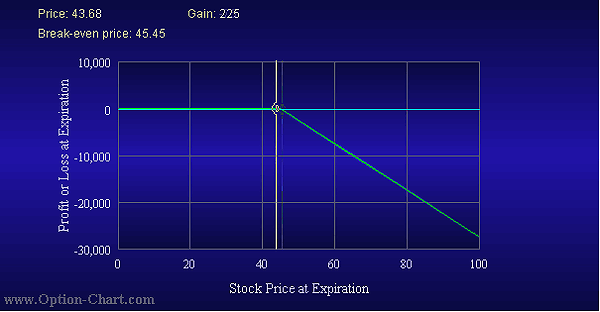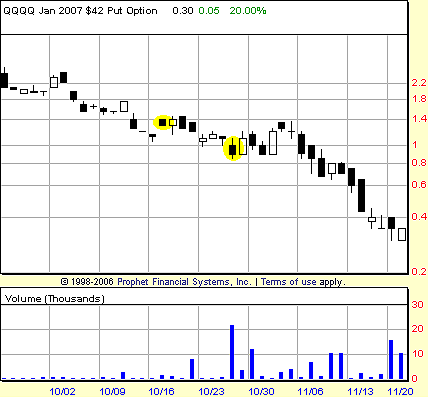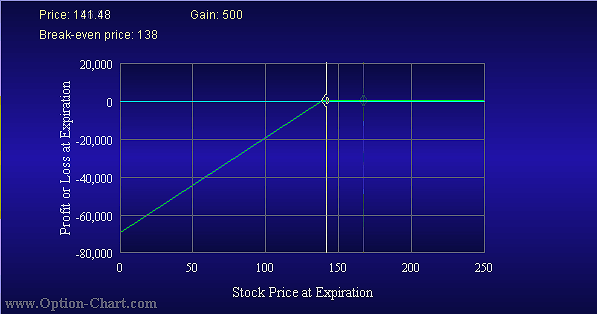
HOT TOPICS LIST
- Strategies
- Stocks
- Buy
- Investing
- Brokers
- Psychology
- Interviews
- Accumulate
- Sell
- Hold
- Spotlight
- Websites
- Candlestick Corner
- Gold & Metals
- Options Trading
LIST OF TOPICS
FOCUS ON
Selling Naked Options
12/22/06 12:30:29 PM PSTby David Penn
Is there a way for the average trader to trade options the way the professionals do?
| Don't tug on Superman's cape. Don't spit in the wind. Don't pull the mask off the ol' Lone Ranger and you don't mess around with selling naked options. With apologies to Jim Croce, from whose classic 1970s hit song "Don't Mess Around with Jim" those lines are borrowed, I think most traders would agree that selling naked options belongs in that class of activities often better left not done. Of all the trades and investments the average trader can participate in -- from IPOs to pink sheet speculation -- selling naked options certainly should rank near the top of the "What? Are you nuts?" category. This impression is one that you come across all the time in investing and trading circles. I was watching Jim Cramer's Mad Money on CNBC one night when Cramer fielded a call from a guy who said he'd been selling naked puts and, from time to time, selling naked calls as well and was making a pretty good penny at it. "Am I crazy?" the guy asked. Replied the King of Cramerica -- who claims to have been as heavy an option player in his day as anybody on Wall Street: "I don't think you know you're crazy. But you are." What's so crazy about selling naked options? Is it as crazy to buy naked options as it is to sell them? Isn't it true that Wall Street professionals sell options to the masses -- and make great coin in doing so? If so, then why can't I get a piece of that action? Consider this both a brief primer on the world of naked option writing ("selling" and "writing" being synonymous when referring to options) and an introduction to a group of money managers who have made selling naked options one of their "stock in trade" and, moreover, are offering to sell naked options for your account (or for your advisement, if you'd rather make the actual trades yourself). While none of what's suggested here should encourage would-be naked option sellers to believe that the risk in this trading approach is overstated, hopefully traders will be able to better decide the degree to which, if any, they want to get involved in what often seems to be the most potent combination of instant gratification and Scheudenfreude on Wall Street. OPTIONS UNCLOTHED
We understand that an option represents the right, but not the obligation, to buy or sell an asset at a certain price at a certain time in the future. To buy an option is to acquire that right. To sell an option, on the other hand, is to grant that same right to somebody else. It also means that the option writer may have an obligation to provide that underlying asset to the option buyer if the trade goes against the writer of the option. The purchaser of an option does just that: Pay the seller an upfront fee -- the cost of the option -- with the hope that one of two things will take place. For the option buyer one preferred outcome is that the option will increase in value because the underlying has increased in value, after which time the buyer will sell the option before expiration and profit from the difference between the amount paid and the amount received after the option value increase. The other preferred outcome occurs when the buyer waits until expiration and then exercises his right to buy (if calls were purchased) or sell (if puts were purchased) the underlying asset at the strike price. See Figure 1.
|
| The naked option writer or seller, on the other hand, hopes the option will decrease in value after he or she has sold it. Many, if not most, option sellers will look to cover the sale by buying back the option at its reduced price, pocketing the difference between what he or she sold it for and the buyback price as profit. If the naked option seller has done a particularly good job, then as expiration approaches the option will be worth less and less -- eventually becoming worthless by the time expiration rolls around. In such an instance, the naked option seller does not even have to worry about covering the short -- after all, the options he or she sold are now worthless. If the option writer finds him- or herself at expiration having sold an option that still has value -- or if the option holder simply elects to exercise the option before expiration -- then things can get difficult for the seller. In this situation, the option buyer exercises his or her right to buy (calls) or sell (puts) the underlying asset at the strike price. The option writer would be obligated to either buy the underlying asset (if puts are exercised) or sell the underlying asset (if calls are exercised). On this note, it is worth pointing out that most options are not exercised and are, instead, bought and sold before expiration. So what's the difference in risk/reward, then? On the surface, selling puts and buying calls (both bullish trades) might appear to be two different ways of doing the same thing. However, there is a key ingredient in selling options that makes them especially attractive to many traders, beyond what I referred to fleetingly as the "instant gratification" aspect. And that ingredient is the effect of time. PUTTING TIME ON YOUR SIDE What is considered by many to be a disadvantage in selling options -- the fact that profit is limited and risk is, potentially, unlimited -- helps condition the expectation and trading that goes on in MarketVolume's NOTS. For example, the program shoots for a relatively modest 25% gain per trade target ("relatively" in comparison with the gains typically expected by those who buy options). A quick glance over the trades in the system shows that it has been effective in capturing an average profit of about 32% in 2005 (including one December 2004 trade; apparently the system's first), and an average profit of a little over 19% in 2006. In accord with the system's income-oriented approach, the drawdowns since December 2004 have been few and far between -- even if they have been disproportionately large compared to the percentage gains. For example, as of this writing there was only one losing trade in 2006 -- but that losing trade was more than three times larger in percentage terms than the average profit per trade. As most traders know (or learn), there are a number of ways to skin the profitability cat: one is by having a relatively equal number of winners and losers, as long as the winners are significantly large enough that they manage to offset the losing trades. Another way of being a profitable trader is simply to be right far more often than you are wrong (that is, more winners than losers by a significant margin), allowing for the possibility that the average (and hopefully infrequent) losing trade will be larger in size than the average winning trade. Some approaches work better with certain trading methods, and some approaches work better with certain traders. But both methods, one in which a trader seeks to maximize the degree to which he or she is right and minimize the degree to which he or she is wrong, and the other in which a trader seeks to maximize the number of times he or she is correct, are valid ways for traders to make money in the marketplace. In the case of MarketVolume's NOTS, it is clearly the latter approach to profitability that has been adopted. "If you are not greedy with your profits," Korzinin warns, then an income-oriented options system like this one can be effective for every level of trader. He acknowledges that most traders think that writing options is "only for institutions" and that "you can lose your pants" trying to sell options. But the keys to success with his approach involve time, discipline, and a sense of the intermediate trend. And the trader who can master his or her relationship to all three factors is the trader who can, against the odds, make money as a writer of options. See Figure 2.
|
| With regard to time, Korzinin underscores the idea that insofar as options are a "wasting asset" (meaning their value, all else being equal, deteriorates over time), time is on the side of the option seller, not the buyer. "Option writing takes advantage of non-trending markets," Korzinin points out. While the option buyer needs movement toward the given stock price, the option seller can profit from no movement in the option -- and only the slow degrading passage of time -- as well as movement away from the strike price. While this still may seem as if option buyers and sellers are relatively two sides of the same coin, anybody who has watched a long option position (the position of an option buyer, as opposed to a short option position that an option writer or seller would have) slowly dissolve into nothingness as the underlying asset refused to move significantly in either direction, will instantly understand the advantage the option seller (or the purchaser of the underlying asset itself, for that matter) has in such a situation. With regard to discipline, Korzinin's admonition to not be "greedy with your profits" is worth recalling. MarketVolume.com's NOTS page includes an "Answer Box" that looks into some of the ways that traders can best manage their money when trading options. Starting with three basic money management approaches (reinvest both the principal and accrued profits, invest a fixed percentage of the portfolio, and invest a fixed amount), the "Answer Box" provides an explanation of all three money management styles, examples (in both words and in an easy-to-compare table) and recommendations as to the suitability of the given money management style to options trading (hint: reinvesting both the principal and accrued profits is "not recommended for options trading!"). The preferred approaches all emphasize the ability to recover from losses, the potential for compounding (if present), and the avoidability of the risk of ruin (that is, losing the entire options portfolio). It is also worth pointing out that the relatively brief track record of the naked option program with MarketVolume still provides enough benchmarks for a trader to know whether he or she is asking more of the system than it has been accustomed to provide. Knowing that the system aims for 25% average returns, a high number of profitable trades, and the occasional loss that will be some small multiple of the average return ("small" meaning 2X or 3X), makes trade management as easy and as straightforward as money management. BEFRIEND THE TREND Recall that by selling options, Korzinin makes both a directional bet and time or duration bet that allows him to win even if the underlying asset does not follow the midterm trend that he anticipated. For him, the midterm or intermediate trend is approximately "six weeks to "three to five months" and the options he likes to write tend to be three or four months out (though not always: October and November QQQQ signals both called for taking positions using January options). See Figure 3.
|
| Where do the signals for the "Naked Options Trading System" come from? As a product of MarketVolume.com, the same signals that have been used to such success in trading exchange traded funds (ETFs) such as the DIA, SPY, and QQQQ themselves are at work in NOTS. (See my earlier, Working-Money.com profile of MarketVolume.com for more on their signal generation methodology.) Keying in on volume surges as derived from real-time volume analysis, MarketVolume is able to anticipate instances of buying and support volume as well as selling and resistance volume in order to optimize entries into the market. More specifically, as I wrote in my profile of MarketVolume.com almost a year ago, support volume occurs when there are surges in the volume moving average during a market decline, while resistance volume occurs when there are surges in the volume moving average during a market rally. Are there other ways to game the intermediate trend that Korzinin says is key to writing options successfully? Most basically, option traders should be as aware of the movement of their underlying asset or stock on the weekly chart as much as the daily. Whether or not an option trader hopes to capitalize on a shorter-term movement within the intermediate trend or is more willing to give a trade six weeks or more to materialize, an understanding of what kind of wind is at his or her back over the coming weeks makes it easier to put the volatility of options into the proper money management and trader psychology perspective. One telling aspect of MarketVolume.com's NOTS is that the signals it generates are not identical to those derived from its other option buying-oriented system. Not only does this suggest that interested traders could subscribe to both systems without fear of redundancy, but also it makes clear that those traders -- most retail option traders -- who are currently buying calls and puts could easily make a naked options selling program like this one a part of their overall option trading strategy. |
| SUGGESTED READING Gross, LeRoy [1999]. The Conservative Investor's Guide to Trading Options, John Wiley & Sons. Headley, Price [2002]. Big Trends in Trading, John Wiley & Sons. McMillan, Lawrence G. [2004]. McMillan on Options, John Wiley & Sons. _____ [2002]. Profit with Options, John Wiley & Sons. Fullman, Scott [1992]. Options: A Personal Seminar, New York Institute of Finance. Penn, David [2005]. "V is for Volume," Working-Money.com, December 28. Sperandeo, Victor. [1991]. Trader Vic: Methods Of A Wall Street Master, John Wiley & Sons. Option charts courtesy of Option-Chart.com Price chart courtesy of Prophet Financial Systems |
Technical Writer for Technical Analysis of STOCKS & COMMODITIES magazine, Working-Money.com, and Traders.com Advantage.
| Title: | Traders.com Technical Writer |
| Company: | Technical Analysis, Inc. |
| Address: | 4757 California Avenue SW |
| Seattle, WA 98116 | |
| Phone # for sales: | 206 938 0570 |
| Fax: | 206 938 1307 |
| Website: | www.traders.com |
| E-mail address: | DPenn@traders.com |
Traders' Resource Links | |
| Charting the Stock Market: The Wyckoff Method -- Books | |
| Working-Money.com -- Online Trading Services | |
| Traders.com Advantage -- Online Trading Services | |
| Technical Analysis of Stocks & Commodities -- Publications and Newsletters | |
| Working Money, at Working-Money.com -- Publications and Newsletters | |
| Traders.com Advantage -- Publications and Newsletters | |
| Professional Traders Starter Kit -- Software | |
PRINT THIS ARTICLE

|

Request Information From Our Sponsors
- StockCharts.com, Inc.
- Candle Patterns
- Candlestick Charting Explained
- Intermarket Technical Analysis
- John Murphy on Chart Analysis
- John Murphy's Chart Pattern Recognition
- John Murphy's Market Message
- MurphyExplainsMarketAnalysis-Intermarket Analysis
- MurphyExplainsMarketAnalysis-Visual Analysis
- StockCharts.com
- Technical Analysis of the Financial Markets
- The Visual Investor
- VectorVest, Inc.
- Executive Premier Workshop
- One-Day Options Course
- OptionsPro
- Retirement Income Workshop
- Sure-Fire Trading Systems (VectorVest, Inc.)
- Trading as a Business Workshop
- VectorVest 7 EOD
- VectorVest 7 RealTime/IntraDay
- VectorVest AutoTester
- VectorVest Educational Services
- VectorVest OnLine
- VectorVest Options Analyzer
- VectorVest ProGraphics v6.0
- VectorVest ProTrader 7
- VectorVest RealTime Derby Tool
- VectorVest Simulator
- VectorVest Variator
- VectorVest Watchdog



